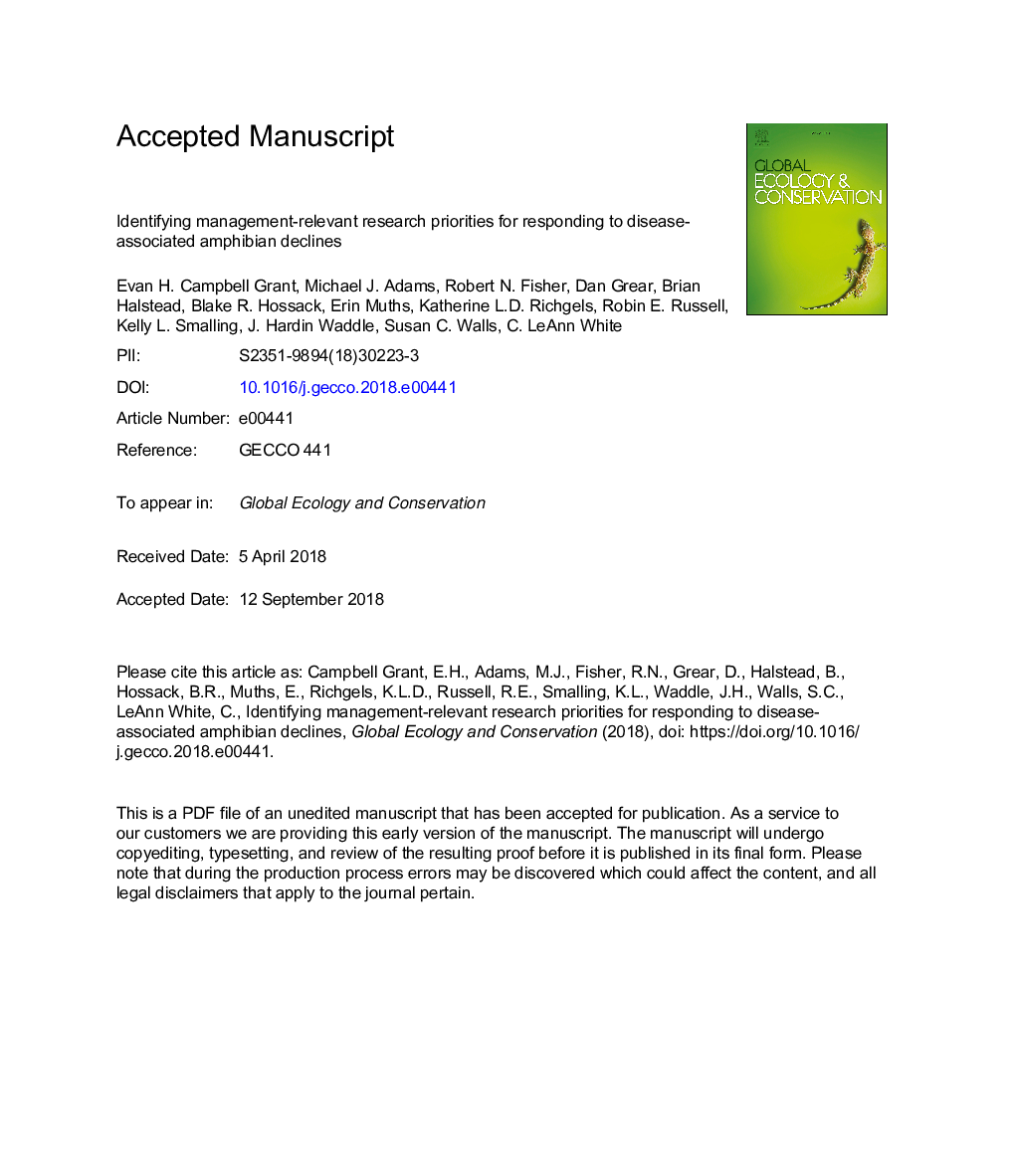| کد مقاله | کد نشریه | سال انتشار | مقاله انگلیسی | نسخه تمام متن |
|---|---|---|---|---|
| 11008234 | 1840464 | 2018 | 31 صفحه PDF | دانلود رایگان |
عنوان انگلیسی مقاله ISI
Identifying management-relevant research priorities for responding to disease-associated amphibian declines
ترجمه فارسی عنوان
شناسایی اولویت های پژوهشی مربوط به مدیریت مربوط به پاسخ به کاهش بیماری دوزیستی مرتبط با بیماری
دانلود مقاله + سفارش ترجمه
دانلود مقاله ISI انگلیسی
رایگان برای ایرانیان
ترجمه چکیده
اولویت تحقیق می تواند به عنوان یک شکاف دانش تعریف شود که، اگر حل شود، مسیر مطلوب اقدام حفاظت را مشخص می کند. ما (گروهی از دانشمندان محقق توزیع شده و چندرسانه ای جغرافیایی) از ابزار نظریه گروهی اسمی و تجزیه و تحلیل تصمیم گیری استفاده کردیم تا به طور مشترک شناسایی و اولویت بندی نیازهای اطلاعات را در زمینه کاهش بیماری دوزیستان مرتبط با بیماری، به منظور ایجاد یک استراتژی که از سازمان مدیریت ایالات متحده نیاز دارد. نمودارهای نفوذ تکراری برای ایجاد و ارزیابی یک استراتژی تحقیقاتی یکپارچه ایجاد کردیم. ما یک فرآیند شفاف برای شناسایی شکاف دانش مشخص در محیط زیست دوزیستان مربوط به مدیریت زیست محیطی را نشان دادیم و سپس یک طرح پژوهشی برای حل این عدم قطعیت ایجاد کردیم. اولویت های حاصل شده شامل نیاز به (1) درک ریشه های ارتباط بیماری بیماری های اجتماعی (2) تعیین مکانیزم هایی است که از طریق آنها قرار گرفتن در معرض آلودگی ها بر پیامدهای بیماری تأثیر می گذارد؛ (3) شناسایی عناصر زیستگاه های زمین و آبزی که ثبات می دهند؛ داینامیک پاتوژن، (4) بحث در مورد چگونگی مدیریت متابولیت ها برای کاهش سرعت و شدت شیوع بیماری ها، و (5) تعریف رابطه بین مدیریت زیستگاه با میکروبیوم محیط زیست و میزبان. همراه با شناسایی اولویت های تحقیقاتی در زمینه مدیریت بیماری، ما جزئیات فرآیند مورد استفاده برای ایجاد یک طرح اجماع برای رسیدگی به کاهش بیماری مرتبط با دوزیستان در سرزمین های مدیریتی فدرال ایالات متحده را ارائه می کنیم.
موضوعات مرتبط
علوم زیستی و بیوفناوری
علوم کشاورزی و بیولوژیک
بوم شناسی، تکامل، رفتار و سامانه شناسی
چکیده انگلیسی
A research priority can be defined as a knowledge gap that, if resolved, identifies the optimal course of conservation action. We (a group of geographically distributed and multidisciplinary research scientists) used tools from nominal group theory and decision analysis to collaboratively identify and prioritize information needs within the context of disease-associated amphibian decline, in order to develop a strategy that would support US management agency needs. We developed iterated influence diagrams to create and assess a unified research strategy. We illustrated a transparent process for identifying specific knowledge gaps in amphibian disease ecology relevant to environmental management, and then constructed a research plan to address these uncertainties. The resulting priorities include a need to: (1) understand the drivers of the community-disease relationship, (2) determine the mechanisms by which exposure to contaminants influence disease outcomes, (3) identify elements of terrestrial and aquatic habitats that stabilize host-pathogen dynamics, (4) discuss how metapopulations may be managed to reduce the speed and intensity of disease outbreaks, and (5) define the relationship between habitat management and the environmental and host microbiomes. Along with identifying research priorities for disease management, we present the details of the process used to develop a consensus plan for addressing disease-related declines in amphibians on federally managed lands of the United States.
ناشر
Database: Elsevier - ScienceDirect (ساینس دایرکت)
Journal: Global Ecology and Conservation - Volume 16, October 2018, e00441
Journal: Global Ecology and Conservation - Volume 16, October 2018, e00441
نویسندگان
Evan H. Campbell Grant, Michael J. Adams, Robert N. Fisher, Daniel A. Grear, Brian J. Halstead, Blake R. Hossack, Erin Muths, Katherine L.D. Richgels, Robin E. Russell, Kelly L. Smalling, J. Hardin Waddle, Susan C. Walls, C. LeAnn White,
